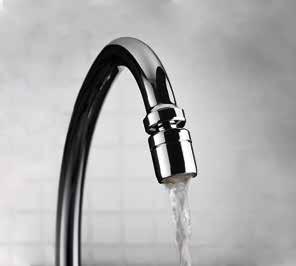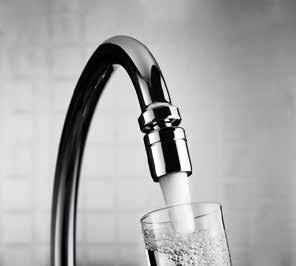
3 minute read
Pumps
Pump up the pressure
A trickling tap can be a nuisance, especially when it’s in a high-use location such as the kitchen or bathroom. But when only one tap or outlet is the issue, installing a pump to improve the water flow throughout the property can feel a bit like overkill. Salamander Pumps technical director Gareth Richards looks at the causes of poor outlet performance and how it can be improved.
What can cause poor water performance at a single outlet?
There’s a variety of reasons that an outlet may not be performing the way it should: it could be a blocked pipe, a leak, or having low-flow fixtures installed. If the reduced flow is down to any of these, there are quick and easy remedies, such as replacing the fixtures, which often don’t require the help of a tradesperson at all.
However, another possible cause can relate to the home’s plumbing system, which may have been changed, extended
or replaced. This can produce a variation in water pressure and flow across the system and crucially, at different outlets. And while this sounds like it may be complicated to fix, the solution is very simple.
A single-outlet booster pump can be fitted to the outlet that needs boosting, even if that outlet is just the hot tap on one sink in one bathroom. It’s a more cost-effective solution than installing a whole-house pump when the water performance at only one outlet needs to be improved.
These pumps are designed to add up to 6 litres of additional flow to an outlet and offer an easy solution for when a slow-flowing kitchen tap means the kettle takes an age to fill, a trickling bathroom tap is making washing hands difficult, or the toilet cistern takes a long time to refill.
For example, if the tap has a flow rate of 2 litres per minute, installing a single-outlet booster pump will improve the water performance by adding approximately 4.5 litres per minute, giving a total of 6.5 litres per minute out of the tap.
These pumps can also be fitted at many different points around the home – bathroom and kitchen sinks, bath taps, garden taps, toilet cisterns, dishwashers, washing machines and showers.
Their inline design also means they can be installed in any plumbing system – mains-fed or gravity-fed – making it a suitable solution for any property.
How to know when to boost the whole house
If there is more than one outlet in a home that is not performing, then it can be more effective to install a whole-house solution to boost the water performance. These solutions vary depending on the home’s plumbing system but options include fitting a whole house pump, a larger inline pump, or an accumulator tank.
Homes with a gravity-fed system should look at bathroom or whole-house pumps. These can boost hot and/or cold water supplies to multiple outlets, including showers, baths, basins, and toilets.
Alternatively, homes with a mains-fed system should look to install larger inline pumps or accumulator tanks. Inline pumps increase the water flow across the whole house to up to 12 litres per minute, in line with the Water Supply (Water Fittings) Regulations: however, accumulator tanks can provide a flow much beyond this.
For larger homes with greater water demand, 12 litres per minute may not be sufficient to run multiple showers and outlets simultaneously. In these instances, installing an accumulator tank allows for greater flow rates to be delivered, up to 36 litres per minute per tank. If more than 36 litres per minute are required, multiple tanks can be linked to provide additional capacity.
Poor water pressure is a common problem in homes: research shows that 40 per cent of people say they suffer from low water pressure on a daily basis. But just because it’s a common issue doesn’t mean it’s something that a household needs to put up with.
No matter how many problem points there are, the home’s plumbing system, or the size of the property, there’s a solution available. ■

Before
After







